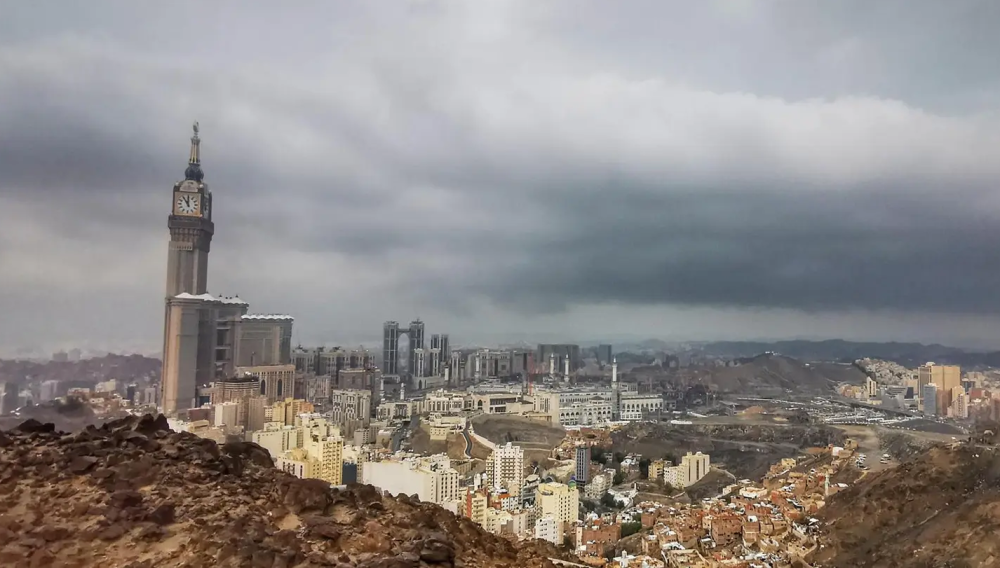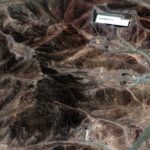The National Center of Meteorology has issued a red alert for heavy rainfall in Makkah, expected to continue until 9 PM.
Associated impacts include high-speed winds, reduced horizontal visibility, hail, flash floods, and thunderstorms.
In its weather report for today, the National Center of Meteorology predicts continued moderate to heavy thunderstorms leading to flash floods, accompanied by hail and strong winds in parts of Jazan, Asir, Al Baha, and Makkah regions.
Light to moderate rainfall is expected in parts of Madinah, Tabuk, Al-Jouf, and the Northern Borders regions, as well as some areas of Najran.
Meanwhile, skies will be partly to mostly cloudy, with a chance of light thunderstorms accompanied by dust-raising winds in parts of the Eastern Province, Riyadh, and Al-Qassim regions.
Makkah
Mecca (Makkah) is the holiest city in Islam, located in Saudi Arabia. It is the birthplace of the Prophet Muhammad and the site of the Kaaba, the sacred cube-shaped structure at the center of the Masjid al-Haram, toward which Muslims worldwide pray. Every year, millions of Muslims perform Hajj, the annual pilgrimage to Mecca, which is one of the Five Pillars of Islam and dates back to the time of Prophet Abraham (Ibrahim) in Islamic tradition.
Jazan
Jazan is a coastal city in southwestern Saudi Arabia, known for its strategic location near the Red Sea and its rich agricultural lands. Historically, it has been an important trade and fishing hub, with influences from various cultures due to its proximity to Yemen and East Africa. Today, Jazan is part of Saudi Arabia’s Vision 2030 development plans, aiming to boost tourism and economic growth through projects like the Jazan Economic City.
Asir
Asir is a mountainous region in southwestern Saudi Arabia known for its stunning landscapes, cool climate, and rich cultural heritage. Historically, it was home to ancient tribes and served as a key trade and agricultural hub due to its fertile highlands. Today, it is famous for its traditional villages, terraced farms, and vibrant festivals that showcase the unique heritage of the local tribes.
Al Baha
Al Baha is a scenic region in southwestern Saudi Arabia, known for its lush mountains, dense forests, and traditional villages. Historically, it was part of the ancient trade routes and home to indigenous tribes, with a rich cultural heritage reflected in its stone architecture and local crafts. Today, it is a popular tourist destination, offering a mix of natural beauty and historical sites like the Shada Palace and the hanging villages of Thee Ain and Al-Habala.
Madinah
Madinah (Medina), officially known as Al-Madinah Al-Munawwarah (“The Enlightened City”), is the second holiest city in Islam, located in Saudi Arabia. It is where the Prophet Muhammad migrated in 622 CE (the Hijra), establishing the first Muslim community and the Islamic calendar. The city is home to the Prophet’s Mosque (Al-Masjid an-Nabawi), which contains his tomb and is a major pilgrimage site for Muslims worldwide.
Tabuk
Tabuk is a historic city in northwestern Saudi Arabia, known for its strategic location along ancient trade routes. It holds significant Islamic heritage, as it was the site of the Expedition of Tabuk led by the Prophet Muhammad in 630 CE. Today, the region features archaeological sites, such as the Tabuk Castle, and serves as a gateway to Saudi Arabia’s growing tourism destinations.
Al-Jouf
Al-Jouf, located in northern Saudi Arabia, is a historically rich region known for its ancient archaeological sites and agricultural heritage. It was once a key part of the Nabatean and Assyrian trade routes, with landmarks like the Marid Castle and the ancient ruins of Dumat al-Jandal reflecting its significance. Today, Al-Jouf is also famous for its olive groves, producing some of the finest olive oil in the country.
Najran
Najran is a historic city in southwestern Saudi Arabia, near the Yemeni border, known for its rich cultural heritage and ancient archaeological sites. It was once a key stop on the incense trade route and is home to the Al-Ukhdood archaeological area, which dates back over 2,000 years and includes ruins of ancient settlements and inscriptions. Today, Najran blends traditional mud-brick architecture with modern development, reflecting its deep history as a crossroads of trade and culture.






